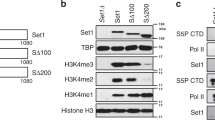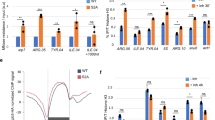Abstract
The histone chaperone SET is required for transcription of chromatin templates by RNA polymerase Pol II (Pol II) in vitro. Here we uncover a positive role for SET in dislodging DEK and PARP1, which restrict access to chromatin in the absence of SET and the PARP1 substrate NAD+. SET binds chromatin, dissociating DEK and PARP1 to allow transcription in the absence of NAD+. In the absence of SET, depletion of DEK restores chromatin accessibility to endonuclease but does not permit Mediator recruitment or transcription. In the presence of NAD+, PARP1 poly(ADP-ribosyl)ates and evicts DEK (and itself) from chromatin to permit Mediator loading and transcription independent of SET. An artificial DEK variant resistant to SET and PARP1 represses transcription, indicating a requirement for DEK removal. Therefore, SET, DEK and PARP1 constitute a network governing access to chromatin by the transcription machinery.
This is a preview of subscription content, access via your institution
Access options
Subscribe to this journal
Receive 12 print issues and online access
$189.00 per year
only $15.75 per issue
Buy this article
- Purchase on Springer Link
- Instant access to full article PDF
Prices may be subject to local taxes which are calculated during checkout






Similar content being viewed by others
References
Kadonaga, J.T. Regulation of RNA polymerase II transcription by sequence-specific DNA binding factors. Cell 116, 247–257 (2004).
Lemon, B. & Tjian, R. Orchestrated response: a symphony of transcription factors for gene control. Genes Dev. 14, 2551–2569 (2000).
Gamble, M.J., Erdjument-Bromage, H., Tempst, P., Freedman, L.P. & Fisher, R.P. The histone chaperone TAF-I/SET/INHAT is required for transcription in vitro of chromatin templates. Mol. Cell. Biol. 25, 797–807 (2005).
Guermah, M., Palhan, V.B., Tackett, A.J., Chait, B.T. & Roeder, R.G. Synergistic functions of SII and p300 in productive activator-dependent transcription of chromatin templates. Cell 125, 275–286 (2006).
Santoso, B. & Kadonaga, J.T. Reconstitution of chromatin transcription with purified components reveals a chromatin-specific repressive activity of p300. Nat. Struct. Mol. Biol. 13, 131–139 (2006).
Kornberg, R.D. & Lorch, Y. Chromatin and transcription: where do we go from here. Curr. Opin. Genet. Dev. 12, 249–251 (2002).
Belotserkovskaya, R. et al. FACT facilitates transcription-dependent nucleosome alteration. Science 301, 1090–1093 (2003).
Kireeva, M.L. et al. Nucleosome remodeling induced by RNA polymerase II: loss of the H2A/H2B dimer during transcription. Mol. Cell 9, 541–552 (2002).
Orphanides, G., Wu, W.H., Lane, W.S., Hampsey, M. & Reinberg, D. The chromatin-specific transcription elongation factor FACT comprises human SPT16 and SSRP1 proteins. Nature 400, 284–288 (1999).
Studitsky, V.M., Walter, W., Kireeva, M., Kashlev, M. & Felsenfeld, G. Chromatin remodeling by RNA polymerases. Trends Biochem. Sci. 29, 127–135 (2004).
Jenuwein, T. & Allis, C.D. Translating the histone code. Science 293, 1074–1080 (2001).
Bustin, M., Catez, F. & Lim, J.H. The dynamics of histone H1 function in chromatin. Mol. Cell 17, 617–620 (2005).
Kraus, W.L. & Lis, J.T. PARP goes transcription. Cell 113, 677–683 (2003).
Rouleau, M., Aubin, R.A. & Poirier, G.G. Poly(ADP-ribosyl)ated chromatin domains: access granted. J. Cell Sci. 117, 815–825 (2004).
Kim, M.Y., Mauro, S., Gevry, N., Lis, J.T. & Kraus, W.L. NAD+-dependent modulation of chromatin structure and transcription by nucleosome binding properties of PARP-1. Cell 119, 803–814 (2004).
Muto, S. et al. Relationship between the structure of SET/TAF-Ibeta/INHAT and its histone chaperone activity. Proc. Natl. Acad. Sci. USA 104, 4285–4290 (2007).
Park, Y.J. & Luger, K. The structure of nucleosome assembly protein 1. Proc. Natl. Acad. Sci. USA 103, 1248–1253 (2006).
von Lindern, M. et al. Can, a putative oncogene associated with myeloid leukemogenesis, may be activated by fusion of its 3′ half to different genes: characterization of the set gene. Mol. Cell. Biol. 12, 3346–3355 (1992).
Matsumoto, K., Nagata, K., Ui, M. & Hanaoka, F. Template activating factor I, a novel host factor required to stimulate the adenovirus core DNA replication. J. Biol. Chem. 268, 10582–10587 (1993).
Loven, M.A., Muster, N., Yates, J.R. & Nardulli, A.M. A novel estrogen receptor α-associated protein, template-activating factor Iβ, inhibits acetylation and transactivation. Mol. Endocrinol. 17, 67–78 (2003).
Miyamoto, S. et al. Positive and negative regulation of the cardiovascular transcription factor KLF5 by p300 and the oncogenic regulator SET through interaction and acetylation on the DNA-binding domain. Mol. Cell. Biol. 23, 8528–8541 (2003).
Seo, S.B. et al. Regulation of histone acetylation and transcription by INHAT, a human cellular complex containing the set oncoprotein. Cell 104, 119–130 (2001).
Suzuki, T. et al. Functional interaction of the DNA-binding transcription factor Sp1 through its DNA-binding domain with the histone chaperone TAF-I. J. Biol. Chem. 278, 28758–28764 (2003).
Nowak, S.J., Pai, C.Y. & Corces, V.G. Protein phosphatase 2A activity affects histone H3 phosphorylation and transcription in Drosophila melanogaster. Mol. Cell. Biol. 23, 6129–6138 (2003).
Haruki, H., Okuwaki, M., Miyagishi, M., Taira, K. & Nagata, K. Involvement of template-activating factor I/SET in transcription of adenovirus early genes as a positive-acting factor. J. Virol. 80, 794–801 (2006).
Waldmann, T., Scholten, I., Kappes, F., Hu, H.G. & Knippers, R. The DEK protein–an abundant and ubiquitous constituent of mammalian chromatin. Gene 343, 1–9 (2004).
Kraemer, D., Wozniak, R.W., Blobel, G. & Radu, A. The human CAN protein, a putative oncogene product associated with myeloid leukemogenesis, is a nuclear pore complex protein that faces the cytoplasm. Proc. Natl. Acad. Sci. USA 91, 1519–1523 (1994).
von Lindern, M. et al. The translocation (6;9), associated with a specific subtype of acute myeloid leukemia, results in the fusion of two genes, dek and can, and the expression of a chimeric, leukemia-specific dek-can mRNA. Mol. Cell. Biol. 12, 1687–1697 (1992).
Adkins, M.W., Howar, S.R. & Tyler, J.K. Chromatin disassembly mediated by the histone chaperone Asf1 is essential for transcriptional activation of the yeast PHO5 and PHO8 genes. Mol. Cell 14, 657–666 (2004).
Boeger, H., Griesenbeck, J., Strattan, J.S. & Kornberg, R.D. Removal of promoter nucleosomes by disassembly rather than sliding in vivo. Mol. Cell 14, 667–673 (2004).
Tulin, A. & Spradling, A. Chromatin loosening by poly(ADP)-ribose polymerase (PARP) at Drosophila puff loci. Science 299, 560–562 (2003).
Nagata, K. et al. Replication factor encoded by a putative oncogene, set, associated with myeloid leukemogenesis. Proc. Natl. Acad. Sci. USA 92, 4279–4283 (1995).
Waters, R., Ramsay, F. & Barrett, I. 3-Aminobenzamide, an inhibitor of poly ADP-ribose polymerase, decreases the frequency of alkaline labile lesions and increases growth in human fibroblasts exposed to 3-methyl 4-nitroquinoline 1-oxide. Carcinogenesis 3, 1463–1467 (1982).
Grozinger, C.M., Chao, E.D., Blackwell, H.E., Moazed, D. & Schreiber, S.L. Identification of a class of small molecule inhibitors of the sirtuin family of NAD-dependent deacetylases by phenotypic screening. J. Biol. Chem. 276, 38837–38843 (2001).
Ito, T. et al. ACF consists of two subunits, Acf1 and ISWI, that function cooperatively in the ATP-dependent catalysis of chromatin assembly. Genes Dev. 13, 1529–1539 (1999).
Bourbon, H.M. et al. A unified nomenclature for protein subunits of mediator complexes linking transcriptional regulators to RNA polymerase II. Mol. Cell 14, 553–557 (2004).
Kim, M.Y., Zhang, T. & Kraus, W.L. Poly(ADP-ribosyl)ation by PARP-1: 'PAR-laying' NAD+ into a nuclear signal. Genes Dev. 19, 1951–1967 (2005).
Ju, B.G. et al. Activating the PARP-1 sensor component of the groucho/ TLE1 corepressor complex mediates a CaMKinase IIdelta-dependent neurogenic gene activation pathway. Cell 119, 815–829 (2004).
Pavri, R. et al. PARP-1 determines specificity in a retinoid signaling pathway via direct modulation of mediator. Mol. Cell 18, 83–96 (2005).
Tulin, A., Stewart, D. & Spradling, A.C. The Drosophila heterochromatic gene encoding poly(ADP-ribose) polymerase (PARP) is required to modulate chromatin structure during development. Genes Dev. 16, 2108–2119 (2002).
von Lindern, M., Poustka, A., Lerach, H. & Grosveld, G. The (6;9) chromosome translocation, associated with a specific subtype of acute nonlymphocytic leukemia, leads to aberrant transcription of a target gene on 9q34. Mol. Cell. Biol. 10, 4016–4026 (1990).
Waldmann, T., Baack, M., Richter, N. & Gruss, C. Structure-specific binding of the proto-oncogene protein DEK to DNA. Nucleic Acids Res. 31, 7003–7010 (2003).
Kappes, F., Burger, K., Baack, M., Fackelmayer, F.O. & Gruss, C. Subcellular localization of the human proto-oncogene protein DEK. J. Biol. Chem. 276, 26317–26323 (2001).
Campillos, M., Garcia, M.A., Valdivieso, F. & Vazquez, J. Transcriptional activation by AP-2α is modulated by the oncogene DEK. Nucleic Acids Res. 31, 1571–1575 (2003).
Cleary, J. et al. p300/CBP-associated factor drives DEK into interchromatin granule clusters. J. Biol. Chem. 280, 31760–31767 (2005).
Hu, H.G., Illges, H., Gruss, C. & Knippers, R. Distribution of the chromatin protein DEK distinguishes active and inactive CD21/CR2 gene in pre- and mature B lymphocytes. Int. Immunol. 17, 789–796 (2005).
Soares, L.M., Zanier, K., Mackereth, C., Sattler, M. & Valcarcel, J. Intron removal requires proofreading of U2AF/3' splice site recognition by DEK. Science 312, 1961–1965 (2006).
Okuwaki, M. & Nagata, K. Template activating factor-I remodels the chromatin structure and stimulates transcription from the chromatin template. J. Biol. Chem. 273, 34511–34518 (1998).
Simbulan-Rosenthal, C.M. et al. Misregulation of gene expression in primary fibroblasts lacking poly(ADP-ribose) polymerase. Proc. Natl. Acad. Sci. USA 97, 11274–11279 (2000).
Ouararhni, K. et al. The histone variant mH2A1.1 interferes with transcription by down-regulating PARP-1 enzymatic activity. Genes Dev. 20, 3324–3336 (2006).
Wilker, E.W. et al. 14–3-3sigma controls mitotic translation to facilitate cytokinesis. Nature 446, 329–332 (2007).
Carro, M.S. et al. DEK expression is controlled by E2F and deregulated in diverse tumor types. Cell Cycle 5, 1202–1207 (2006).
Boer, J., Bonten-Surtel, J. & Grosveld, G. Overexpression of the nucleoporin CAN/NUP214 induces growth arrest, nucleocytoplasmic transport defects, and apoptosis. Mol. Cell. Biol. 18, 1236–1247 (1998).
Kandilci, A., Mientjes, E. & Grosveld, G. Effects of SET and SET-CAN on the differentiation of the human promonocytic cell line U937. Leukemia 18, 337–340 (2004).
Dignam, J.D., Lebovitz, R.M. & Roeder, R.G. Accurate transcription initiation by RNA polymerase II in a soluble extract from isolated mammalian nuclei. Nucleic Acids Res. 11, 1475–1489 (1983).
Acknowledgements
We thank S. Larochelle and J. Lis (Cornell University) for critical review of the manuscript and for many helpful discussions; W. Lee Kraus (Cornell University) for helpful comments and suggestions, for PARP1 and Gal4-VP16 expression vectors and pGEIO plasmid, and for material support during the revision process; H. Erdjument-Bromage and P. Tempst for mass spectrometric identification of DEK, SET and PARP1; T. Ito (Nagasaki University) for core histone–specific antibodies; J. Kadonaga (University of California, San Diego) for NAP1, ISWI and Acf1 baculoviruses; M. Ptashne for Gal4 DNA-binding domain–specific antibodies; and R. Roeder (Rockefeller University) for MED30-specific antibodies. HeLa cells were provided by the National Cell Culture Center (US). This work was supported in part by US National Institutes of Health grant DK45460 to R.P.F.
Author information
Authors and Affiliations
Contributions
M.J.G. designed and executed experiments and prepared the manuscript; R.P.F. prepared the manuscript.
Corresponding author
Ethics declarations
Competing interests
The authors declare no competing financial interests.
Supplementary information
Supplementary Fig. 1
Time course of restriction endonuclease accessibility of chromatin in the presence of SET and/or the PC1 fraction. (PDF 78 kb)
Supplementary Fig. 2
Removal of DEK is not sufficient to restore chromatin transcription of PIC assembly in the absence of SET. (PDF 557 kb)
Supplementary Fig. 3
GST or thrombin does not affect chromatin transcription. (PDF 390 kb)
Rights and permissions
About this article
Cite this article
Gamble, M., Fisher, R. SET and PARP1 remove DEK from chromatin to permit access by the transcription machinery. Nat Struct Mol Biol 14, 548–555 (2007). https://doi.org/10.1038/nsmb1248
Received:
Accepted:
Published:
Issue Date:
DOI: https://doi.org/10.1038/nsmb1248
This article is cited by
-
Identification of therapeutic targets of the hijacked super-enhancer complex in EVI1-rearranged leukemia
Leukemia (2021)
-
The potential predictive value of DEK expression for neoadjuvant chemoradiotherapy response in locally advanced rectal cancer
BMC Cancer (2018)
-
Eviction of linker histone H1 by NAP-family histone chaperones enhances activated transcription
Epigenetics & Chromatin (2015)
-
The DEK oncoprotein and its emerging roles in gene regulation
Leukemia (2015)
-
The DEK oncogene promotes cellular proliferation through paracrine Wnt signaling in Ron receptor-positive breast cancers
Oncogene (2015)



